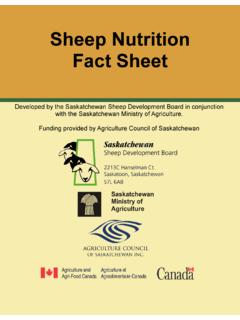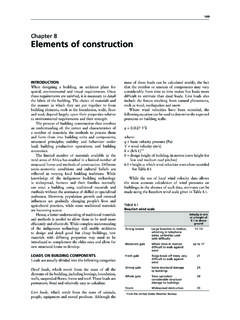Transcription of Understanding Sheep Behaviour - SKSHEEP.COM
1 Introduction to Sheep Handling and Behaviour Understanding Sheep Behaviour is the key when handling Sheep . Understanding Sheep Behaviour Fact Sheet Specific Behaviour Traits Sheep are created with specific Behaviour traits. Knowing what these traits are can make handling them much easier. Sheep are social animals, so try and prevent seclusion. Sheep by nature are followers; let them follow and don t drive them as you would cattle. Sheep are docile animals by nature. Sheep have good memories; these memories need to be positive ones as much as possible. Sheep react to their surroundings, this includes the working environment and facilities; the following suggestions will help make the experience positive: Sheep like routine, so be patient when introducing something new.
2 Sheep reactions are predictable, so use them. Sheep react negatively to loud noises and yelling. Sheep will bunch up in corners to protect themselves. When moving, gathering or sorting Sheep , the more efficient the operation the better; wool grabbing and rough handling will cause bruising. Sheep tend to move in the opposite direction of the handler. Sheep have a flight zone, determine what this is for your flock. Sheep move best when not afraid, so work slowly and calmly. Sheep do not like to move into the darkness; place a chute facing a well lit area. Sheep move better on a flat surface or uphill. Sheep will move towards other Sheep . Sheep will move to a partially full pen.
3 Sheep will move better through long, narrow pens and chutes rather than square pens and wide chute systems. Sheep resist moving from one type of surface to another. Sheep have no depth perception, so shadows, dark surfaces and water are an issue. Sheep fear new visual objects. Sight and Hearing Sheep and other farm animals have a well developed sense of hearing. They capture a wider frequency of sound than is audible to our ears. Thus it is important while feeding and caring for the animals that you talk to them in a calm, reassuring voice. When they sense that you mean no harm, they will turn to their usual business of eating, drinking and feeding their young. Humans have binocular vision, focusing both eyes simultaneously to achieve good depth perception and clarity for objects directly in front of them.
4 However humans peripheral vision is very limited. Sheep see the world through a different set of eyes than ours. Sheep have their eyes set on the side of the head. They have a narrow field of binocular vision in front of their head and wide peripheral fields of monocular vision. The area in the back of the Sheep 's head is a blind spot when their head is raised. If a Sheep is approached from the rear, a handler can remain undetected visually and have a better chance at catching the animal. With its head down in a grazing position the Sheep can see in all directions; a good defensive adaptation whereby the Sheep can see predators' from all sides while grazing. Sheep Behaviour Moving Sheep Sheep can be led by shaking a bucket of grain, driven from the rear by a mover, or both with a dog or person to help.
5 When driving Sheep use a distracting noise first to alert them. A plastic trash bag, rattle( plastic bottle filled with stones), sticks knocked together or a bark from the dog will get the Sheep on their feet and moving away from the noise. Pressure develops from being too close to the flock of Sheep . Use a minimum of noise and pressure so the Sheep travel slowly and take a steady course. Sheep have a psychological distance or flight zone within which they try to distance themselves from the handler. A safe distance to follow behind the flock is three body lengths ( about 10-12 feet) behind the rear of the group. Sheep at a run are out of control, except over long distance. If they are really frightened they will run away in a panic.
6 When this happens only a swift dog can overtake the leader and turn the Sheep around. Guide the Sheep to the pen by moving them at a brisk walk along physical barriers such as a fence line, laneway, the sides of a building etc. Sheep move best on level ground or uphill. Most of their weight is over their rear legs making it awkward to move quickly down hill, especially if the ewes are pregnant. Make sure all the gates are open to the gathering pen. As the Sheep approach, ease the pressure on them so they can find their way through the restricted opening. Holding pens should be rectangular so Sheep flow down to one end, rather than square which may start a circular flow around the edges and back out of the pen.
7 Holding pens and catch pens should have open sides so the Sheep do not feel trapped. They should be able to see other Sheep . Decoys can be used in this manner to lure Sheep into pens or chutes. Crowd the Sheep close in a smaller pen so that the shepherd can handle them easily without them running out of reach. If a small pen is not available, crowd the Sheep into the corner of a large pen, using a portable hinged panel to close in the rear of the group. Secure the ends of the hinged panel to the sides of the pen to confine the animals. The crowding area should have corners with no less than a 90 degree angle to keep the Sheep in the corners from being crushed or smothered. A workable group will be up to five Sheep deep, and four Sheep across (or within arm s length on either side.)
8 Deeper pens of Sheep are more difficult to step through, front to back. The Sheep should be gathered up tightly, with standing room only and a few feet to spare in the rear for you to work an individual. Sheep are too close together when some are piling on top of each other or the weak ones have dropped down out of sight. Let the Sheep quiet down for five to ten minutes before working them again. When you enter the pen, don t climb over rails, use a gate and enter in a non-threatening manner. When moving Sheep up a loading ramp or down a narrow chute stay approximately 10 feet back from the last Sheep to avoid having animals in the rear turn around and run past you. Keeping this distance away from the group gives you time to react to the flow of Sheep while still creating some pressure to move the Sheep forward.
9 If Sheep become wedged together in a narrow spot, move around the bunch to the front and use noise or visual distraction such as a broom or crook to force the Sheep to step backwards. Avoid stepping through the center of the flock because there is no easy escape for you when they free themselves. Do not move Sheep in the heat of the day as they will be slow to gather and suffer from heat exhaustion. Contacts: Agriculture Knowledge Centre 1 - (866) 457-2377 Saskatchewan Ministry of Agriculture Livestock Branch - Regina Rm 202 3085 Albert Avenue (306) 787-4685 Regina, SK S4S 0B1 Livestock Branch - Saskatoon 3830 Thatcher Avenue (306) 933-5992 Saskatoon, SK S7K 2H6 Saskatchewan Sheep Development Board (306) 933-5200 2213C Hanselman Court Saskatoon, SK S7L 6A8 Disclaimer: The information in this fact sheet are based on general averages and differences may occur among breeds and individual animals.
10 The SSDB makes no warranties expressed or implied about the information . It is the users responsibility to evaluate the accuracy and completeness of any content. List of Further Reading: Canadian Agri-Food Research Council, Recommended Code of Practice for the Care and Handling of Sheep Canadian Food Inspection Agency, Livestock Transport Requirements in Canada





